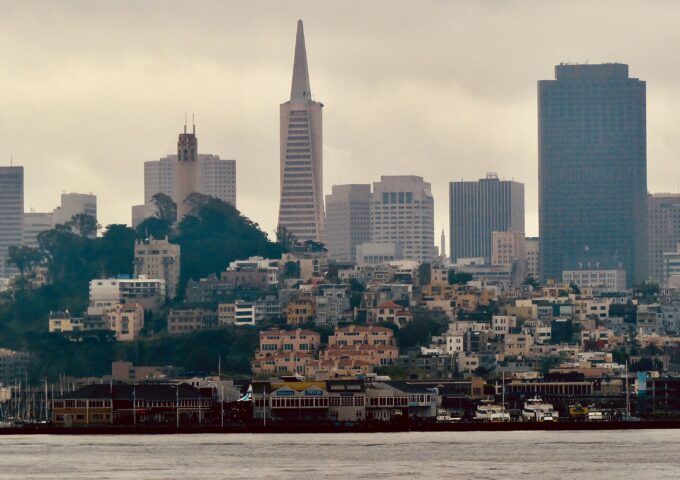

San Francisco waterfront. Photo: Jeffrey St. Clair.
The news that Silicon Valley titans have quietly purchased over 50,000 rural acres in Solano County to build a new city called California Forever has gripped public attention since it appears to offer a way to escape the myriad crises now besetting nearby San Francisco. A nostalgic mashup of Italy’s Portofino and Florida’s Celebration on the sere hills of Solano County, its promoters claim that it will offer a pedestrian-friendly, safe, and sustainable city “for the many generations to come” that the older metropolis to the east allegedly does not. But how sustainable can any growing city be as its demands necessarily sap and change the planet over which they spread?
Cities are by their nature parasitic; they have a metabolism that requires a constant input of water, energy, and raw materials taken from expansive hinterlands for their existence, and in the process of their ceaseless remaking and growth, they produce corresponding floods of waste. Prominent among that waste are the greenhouse gasses that now threaten their very existence let alone further growth.
In a 1962 New Yorker column, Lewis Mumford advised San Franciscans that they should save their city from what growth was doing to efface its best qualities. Titled “Not Yet Too Late,” Mumford said that views from and to the city as well as the light-reflective wooden buildings massed upon its hills that made it beloved around the world were in danger of being sacrificed to what Jane Jacobs called catastrophic finance and Mumford dubbed the Zeckendorf Syndrome after one of America’s  preeminent builders of high rises, New York developer William Zeckendorf. He wrote that “A city that has no use for its waterfront, no use for its beautiful skyline, no use for its aquatic recreational facilities, no use for the apricot orchards and the vineyards of the surrounding countryside has in fact no use for variety and contrast of any kind, and eventually it will have no use for itself, for when it looks in the mirror no expressive, identifiable face will be reflected there.” San Francisco would shortly, Mumford said “reach a point of no return.”
preeminent builders of high rises, New York developer William Zeckendorf. He wrote that “A city that has no use for its waterfront, no use for its beautiful skyline, no use for its aquatic recreational facilities, no use for the apricot orchards and the vineyards of the surrounding countryside has in fact no use for variety and contrast of any kind, and eventually it will have no use for itself, for when it looks in the mirror no expressive, identifiable face will be reflected there.” San Francisco would shortly, Mumford said “reach a point of no return.”
Twenty years later in a 1982 cover story for the New York Times Magazine titled “The Limits to Urban Growth,” architecture critic Paul Goldberger proposed that the quality of life in successful cities such as New York can only decline as density progressively exceeds the fixed capacity of their infrastructure. The same, he said, was true for other American cities such as San Francisco. He did not mention climate breakdown, the awareness of which was then in its infancy except for a few scientists and the presidents they futilely tried to warn.
By the time of Goldberger’s article, the apricot orchards Mumford lauded had succumbed to Silicon Valley’s suburban sprawl while a palisade of new high rises hid the hills of the city he’d tried to warn against permitting them. Cities continue to grow both up and out and will do so until they can’t. And that limitation their very growth is largely bringing upon themselves now.
In 2006, the San Francisco Chronicle published a front-page story entitled “Oceans Rising Fast, New Studies Find.” It featured a map of the shoreline areas of the city predicted to flood in the coming century. Ten years later, however, its architecture critic John King wrote that “New Towers Give Skyline and City Global Character.” Most of those high rises had gone up in precisely the flood zones the newspaper had earlier mapped. The global character that San Francisco shares with other cities is the unheeded warnings that have not hindered upward growth in towns such as Jakarta, London, Bangkok, Dubai, Cardiff, and Miami as they emulate Manhattan.
Midtown Manhattan is today distinguished by construction cranes and vitreous behemoths rising everywhere on its fixed grid. Aside from the shadows those buildings cast and the intolerable traffic about which Goldberger and Mumford warned, they represent towering piles of embodied coal and oil transmuted into steel, concrete, glass, plastic, and daily operations.
Take One Vanderbilt for example, the sleek new 93-storey tower just west of Grand Central Station. The 2015 Environmental Impact Report for its construction estimated that the building would yearly emit as much as 24,140 metric tons of greenhouse gases while construction including materials would total five to ten times that amount. Those emissions would, of course, be dwarfed by the construction and operation of the massed high rises of Hudson Yards on Manhattan’s West Side.
Planners and architects tout the energy conservation of vertical, rather than horizontal, cities while seldom mentioning what high rises require to build and function and the waste they generate in turn. The sculptural oddities into which their architects’ computers sculpt them matter little; it is the city’s ceaseless growth that counts. That applies as much to new cities like California Tomorrow as to older ones like San Francisco and New York. That the very existence of cities around the world are now threatened by extreme weather events, drought, and sea level rise brought by global heating should now be obvious, but less so is their own culpability for what their unimpeded — even celebrated — growth has set in motion to their collective peril.
The post Unheeded Urban Warnings appeared first on CounterPunch.org.
This content originally appeared on CounterPunch.org and was authored by Gray Brechin.